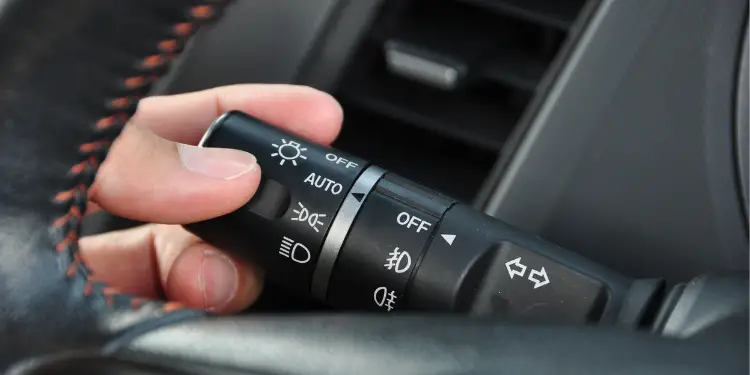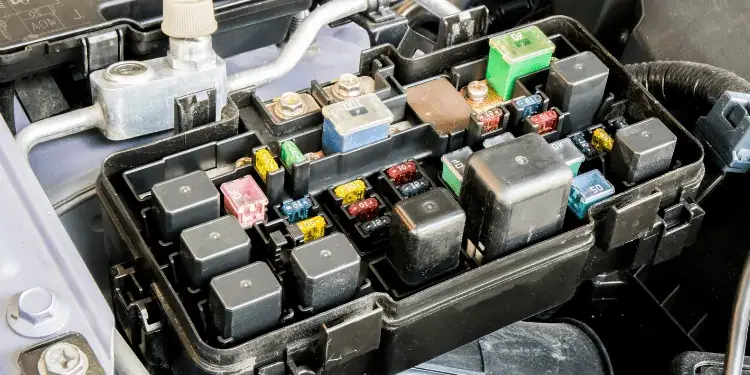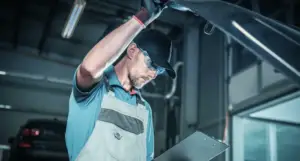So your car lights have taken on a mind of their own and have started to come on by themselves at night.
In this article, we’ll examine why your headlights, brake lights, or interior lights may do this and the causes and fixes that can be done to stop it.
Headlights are the most common lights to come on by themselves at night. Before we examine the four causes of this – and the other interior and brake lights coming on by themselves.
So why do headlights come on at night?
- Automatic headlights
- Smart Key
- Compromised Seal Causing Water Damage
- Faulty Relay
Let’s get into this in more detail.
Headlights
Automatic Headlights
If you have automatic headlights in your vehicle, the vehicle will turn on the lights whenever it’s dark outside. Even after you’ve turned off the engine, lights on the auto setting will remain lit for 3 to 5 minutes. Also, if there’s a problem with the sensor fitted for sensing light intensity, the circuit will default to having the lights on indefinitely.
It’s worth noting that if your headlights turn themselves on after dark when they have been off for some time, this won’t be caused by this setting but could happen in conjunction with faulty wiring.
Solution
Switch to the manual setting on the lights – if this doesn’t work, ensure that the sensor and wiring aren’t faulty. This is unlikely on newer cars but on vehicles over ten years old becomes increasingly common.

Smart Key
It could be a feature that comes with a smart key if you have one for your vehicle. When you have it on your person or close to your car, the dome lights inside the car – and on some cars, the headlights too -are programmed to turn on with the key in a specific range automatically.
In this case, they will turn off after a few minutes but may be reactivated again and repeat this cycle through the night. Some smart keys are programmed to recognize this possibility and will stop the lights from coming on after several activations over a certain period.
Solution
Some smart keys can have this turned off, so speak to your dealership if it is causing you concern or place your key out of range of your car.
Depending on the car model, the range is between 5 and 25 meters.
The distance between where your car is parked and the furthest area away in your home where you could leave the key may be less than the radio signal range, which means your car lights may turn on and off at night.

Compromised Seal
A compromised seal within the lighting control unit might be the culprit, especially for older vehicles. Water may enter through this and cause short circuits and abnormal behavior.
The unit is near or on the steering rack or behind the dashboard in most cars.
During a pressure wash under the hood or steam clean on the interior, moisture may enter parts of the circuitry and cause it to malfunction sporadically.
This fault will be present during the day, but it may only draw your attention at night as it is more obvious.
Solution
It depends on how much moisture the seal has allowed into the unit. If it’s a small amount, you may try using packs of silica gel to dry up the moisture. This is a good and cheap option.
A replacement part may be needed if the water damage is more severe.
Faulty Electronics
Any one of the parts in the circuitry may malfunction and cause abnormal completion of the circuit.
One component to check is the relay: this component serves as the switch in a circuit, and if water has entered it or it’s just served its useful life, it can cause the headlights to turn on themselves.

Besides the relay, any other component could be at fault, too. An easy way to identify which one is to use a voltmeter and trace the power supply while the lights have switched on by themselves (and hence when power reaches the headlights without you turning them on). Following a DIY guide can help you out with this and can quickly lead to the identification of the faulty part.
Solution
A thorough fix is to consult the wiring diagram of the headlight circuitry.
If you have experience in electronics work, it’s easy to trace the wires in the circuitry for the headlights. This can save you valuable time and money by identifying the problem early on and helping you identify what you can fix on your own (without paying a specialized auto electrician).
However, if there is lots of damage and the part is difficult to access, it’s best to consult a mechanic/electrician so that you don’t do any more damage. Car electrics are complex, and DIY mechanics often fix a fault only to discover that they have inadvertently caused an issue within another circuit.
As a final thought on headlights
If you’ve installed custom headlight bulbs, these may overload the built-in switch and circuit breaker.
Using bulbs specified by the manufacturer may solve this issue. If not, the switch itself may need replacement. This issue may also be highlighted by the high beams specifically not working.
Brake Lights
Brake Pedal Sensor
There are multiple sensors in a car’s braking system, and a problem with any one of them can cause the tail lights or brake lights to turn on at night. Usually, it’s the sensor by the brake pedal which is problematic.
Right beside this, a part attached to the pedal that prevents circuit completion may be missing or may have fallen off somehow: a replacement will ensure the normal functioning of the lights.
Solution
There are many DIY guides available online that can help you locate precisely where the missing stopper needs to be placed and how it needs to be fitted. The stopper itself shouldn’t cost more than a few dollars and should be available online.
Brake Light Socket
This may be corroded or grounded poorly, which can interfere with correct operations. Related to this is the brake light switch. A malfunction within it can be another likely source of error with a similar working as the relay described above.
Alternatively, it could be any of the multiple sensors employed in the braking mechanism. Usually, it’s the one on the rim or those used in the braking pedal.
Solution
Although these won’t affect the car’s braking ability, malfunctioning sensors could lead to potential accidents and confusion while driving, especially at night. A prompt replacement is what’s needed.
Interior Lights
A smart key in range will signal the car that the dome light should come on. We’ve discussed that the options are either to keep the smart key out of range or ask the dealer if they can reprogram the key to remove this feature. If that isn’t the cause, then.
Corroded Switches and Bad Grounding
An obvious first place to check is the contacts of the car’s doors. The courtesy light switches will turn on if the contacts on the doors have gone bad or if they’re not grounded properly. This could be either due to wear over time or water, which may have entered the switches. This will be noticeable at night and a problem during the day.
Solution
Use some WD40 on the latches and the switch. If the problem persists, consider having the door panels checked by a mechanic.
The issue could also lie in the wiring connecting the sensors in the door to the light. Since they inevitably pass through the connection of the door and the main car body, they can potentially get chaffed or grazed by either natural wear.
If enough damage is done, the lights may fail to turn on or fluctuate between an on/off pattern.






![How Long Do New Tires Take To Put On? [ANSWERED] Torque-wrench-tire](https://carzaza.com/wp-content/uploads/2023/12/Torque-wrench-tire-300x150.png)
![Can Dirty Brake Fluid Cause Squeaky Brakes? [ANSWERED] DOT-3-Brake-Fluid](https://carzaza.com/wp-content/uploads/2023/12/DOT-3-Brake-Fluid-300x161.png)





